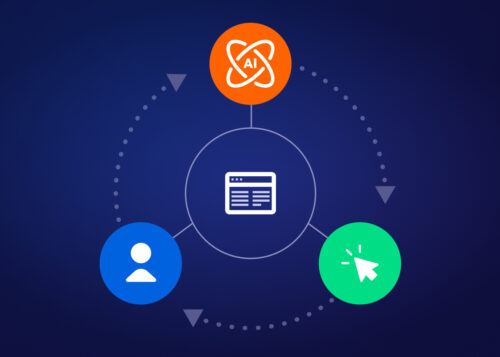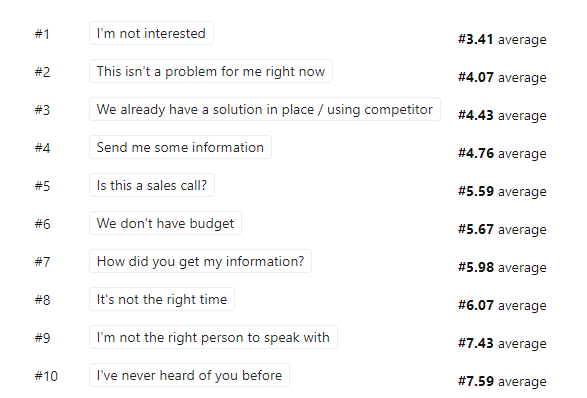Overcoming Common Objections

SDR Symposium | August, 2021
If there’s one thing that ALL salespeople have in common, it’s the need to overcome objections.
Very rarely is a sales pitch not met with either skepticism, disinterest, or an objection of some kind.
And because of that, knowing what to do when faced with an objection is paramount to an SDRs success.
Totally makes sense that it was the most voted for topic by our reps in the symposium series.
This month we grabbed 3 of our top reps and walked through:
-
General objection handling best practices
-
How they handle common objections (voted on by the audience)
The conversation illuminated a few key tactics that any SDR can adopt to help them navigate an objection, plus some new things you can try out!
The Guests

Michelle Buckley
Client Success Manager

Anthony Licciardello
Sr. SDR & Team Lead

Kenny Felix
Sr. SDR
Prefer a video highlight? We got you
Before we even started the symposium, we had a poll go out the week before. Our goal was to find out the answer to this question:
Which objection is the most frustrating to deal with?
We came up with 10, sent out the poll to our reps, and these were the results:
Going through all 10 in an hour was a tall task, so we tackled the most important during our discussion:
-
I’m not interested
-
This isn’t a problem
-
We’re using a competitor
-
Send me some information
-
We don’t have the budget for this
Our panel also dropped some general advice on handling objections and how to prepare for pretty much anything on the phone.
General Tips & Tricks
Before we dove into anything specific from the poll, our panel went through some general advice on dealing with objections.
The main takeaway we heard from all of them? Don’t scramble. The last thing you want to do when faced with an objection of any kind is seem lost. That means that preparation is key. Knowledge is power!
Anthony brought up the importance of knowing your product AND persona. It’s important to know what your solution can and can’t do, but it’s also important to know how your solution impacts the day-to-day of your prospects. The better you understand that, the better you can combat objections when they come up.
Want to get better at understanding personas? Run a reverse role play! Have a colleague prospect YOU and put yourself in the shoes of your prospects. Talk about preparation!
Kenny also noted the importance of being knowledgeable. He leverages his AE and manager to get insight on how to combat certain objections + examples they’ve used successfully in the past. Housing all of that in a searchable doc means he’s never unprepared while going into a call.
Michelle echoed the other panelists and doubles down on the documentation side of things. It’s important to save all of the ammo you can gather into a central location – but it’s also important to have the main points front and center. Remember, you don’t want to scramble. The faster you can find the information you need, the better. If you can take all of your examples & tips and turn them into bullet points, you’ll be able to focus the conversation and keep it organized.
When you take the time to distill your notes into bullets, you learn them all over again. It’s a great way to reinforce what you’ve learned and better put it into practice.
–
Alright, now that we have some basic insight and tips, let’s dig into some specifics.
Objection #1 – I’m Not Interested…
Ahhh, a classic objection. You’ve just rattled off your pitch & value prop thinking you nailed it, only to be met with…
“I’m not interested in your solution.”
What?! Based on targeting, personas, and customer data, this should have been a slam dunk! There must be some kind of disconnect here…
Advice From The Panel
Don’t take the objection at face value. When someone claims they aren’t interested, it’s often a “brush off” tactic. They simply don’t want to talk with you. Anthony is a fan of probing the prospect with more questions. If you can get them talking, you can get to the root of why they’re “not interested” – provided it’s a real objection and they haven’t hung up on you yet.

Props to Jeremy Donovan for this LinkedIn post He encapsulates that idea perfectly – don’t leave the objection as is, you have to probe with questions.
Active Listening is vitally important. If you manage to get the prospect to open up a bit through questioning, this is your chance to learn WHY they said what they said. Are they talking about factors outside of interest like timing, budget, permission, etc. that would alter the course of your conversation? Michelle likes to hone in on something specific she hears and try to springboard that into a conversation around value.
Stop the negativity train. When someone responds with a “not interested” objection, the last thing you want to do is continue down the path of negativity. Kenny follows up this objection with positive words (think: awesome, great, wonderful, etc.) to right the ship a bit. The goal here is to get the conversation back under your control. Otherwise, the prospect holds the cards and will likely steer towards a hang-up or “take me off your list.”
Ultimately, our panel agreed on one major tactic: ask questions. You can’t take the “not interested” objection at face value if you’ve done the right work before making the dial (targeting, account mapping, building a use case). If you can steer the direction towards a specific value prop or illuminate a common pain point, you’ll have it back under your control.
Kenny said something that really hit home with this objection:
“They might not be interested, but if it’s their job to fix something and you make it clear that you’re trying to help, they’ll make time.”
More than likely, a “not interested” response is due to miscommunication or under-education. If you can further clarify why you’re reaching out and the value it brings, you have a better chance of moving the conversation in the right direction.
Objection #2 – This isn’t a problem for us right now…
This one seems more legitimate than the previous objection, and it’s easy enough to take it at face value. After all, your prospect knows a lot more about their situation than you do!
But like with any objection, going a bit deeper can illuminate a lot about how to combat this one.
Advice From The Panel
Use this as a springboard. There’s a chance that the value prop didn’t land because it ISN’T a problem – but your solution solves more than one problem, right? Anthony uses this objection as a springboard to continue the conversation. Just because this one thing is taken care of doesn’t mean your solution has no value to them. You have to dig into their situation a bit deeper to understand where you can bring them value.
Flattery will get you…everywhere. Hearing that someone doesn’t have the problem you thought they did shouldn’t be met with skepticism or sadness. It should be celebrated! After all, you are trying to help this prospect out. Michelle likes to follow-up that objection with praise + a question:
“That’s great! Love to hear that you’re in the minority with this. You know a lot of the people I talk with are struggling with problem X. What are you doing differently that makes it work for you?”
If you can flatter them, you get them talking. And when they start talking, you can employ Anthony’s suggestion from above. Knowing more about their current situation will help you pinpoint other areas your solution can bring value.
Make sure you’re in the right place. Sometimes, when someone mentioned they don’t have a problem you can solve, it could be because they don’t know there’s a problem. Either the situation itself hasn’t been illuminated, or it’s not the prospect’s responsibility to know of the problem in the first place. Kenny talked about illuminating problems as an opportunity to get internal referrals to other stakeholders within the organization. The more people you can talk with the better – it’s more opportunities for you to prove that your solution can help free up time and focus your prospect’s day-to-day on other (more important) tasks.
Objection #3 – We already have something in place.
Ooooh a competitor, huh? What do they have that we don’t?!
It’s easy to hear about a competitor in place and assume nothing can be done. That’s what contracts are for, right?
Wrong. With some careful wording and probing questions, you can use this objection to your advantage.
Advice From The Panel
When’s the last time they looked? The technology landscape moves FAST. Chances are, things have changed quite a bit since your prospect last evaluated a solution like yours. Anthony’s advice is to ask them that: “When did you last evaluate your current solution?” If you can get them talking, they might realize that is has been a long time (too long in some cases). You can spin that into a meeting or introductory call with someone else on your team. Call it a ‘“benchmark” call where your product specialist goes over all of the changes that have happened since they last explored the space and what they could be missing out on. You’re not “selling” them on anything, you’re educating them so a more informed decision can be made in the future.
Want a visual representation of the available technology in the sales development space? Our friends at Tenbound have you covered!
Don’t play divorce attorney. The last thing you want to do is try and separate someone from a solution they love. Kenny uses the line, “I’m not trying to break up any happy marriages.” He makes it clear to the prospect that even though they’re using a competitor, it doesn’t preclude them from exploring what else is out there. At the very least you’re arming prospects with information for future decisions. The more you help someone now, the more favorably they view you and your organization. This is an opportunity for you to play the long game and nurture your prospect until it’s a better time for them to talk (like near the end of their current contract).
Maybe your solution can act as a complementary piece to what’s already in place? Knowing how your product interacts and integrates with different systems can really help you here.
People love to complain. It’s human nature! The more someone talks, the higher the chances are that they complain about something. Michelle really leans into this when digging deeper with her prospects. One second they’re gushing about how their current solution meets their needs, and the next they’re complaining about how it doesn’t do XYZ. This is a great opportunity for you to position yourself against the competition and talk about how your solution could handle that complaint.
It helps a TON if you have a basic working knowledge of your competitor’s values, key customers, strengths, weaknesses, and reviews. Preparation is key! It will allow you to have a more productive conversation and better educate your prospect.
Objection #4 – Just send me some information.
The ultimate ‘“brush-off” objection. When a newer SDR hears this from their prospect, they can originally interpret it as positive.
After sending an email and getting ghosted for the next few weeks, their view changes quickly.
Seeing through the facade of this objection and getting to the root of their problem is key.
Advice From The Panel
Leverage your emails. Emailing a prospect is a more comfortable situation than trying to pitch them live on the phone for most SDRs. They’ll jump at the chance to send an email – but if you do that, it better be a good email. Pack it with info, incentives, customer stories, etc. Sometimes it’s easier to distill the value of your solution into an informative email vs. talking someone through it live.
Kenny likes to follow up the objection with something along the lines of:
“Happy to send an email your way. I can also set up a tentative meeting for a couple of weeks out to review the information I’m sending and clarify anything for you. I’ll make sure a product specialist is present as well – that way we can dig into the finer details if needed.”
If they’re in, great! Set that meeting up. If not, it’s an opportunity for you to dig a bit deeper and find out why that educational call isn’t of interest.
Have them clarify what information they’re looking for. Truth is, people are probably just afraid to say “no.” Asking for more info is their way of letting you down easy. If you think that might be the case, simply ask them what information they’d like to see from you. If they answer with some specifics, chances are they have an actual interest in your solution and want to review information before talking further. If they don’t answer with specifics, it’s probably a brush-off. Anthony employs honesty here. He will bluntly ask the prospects if they’re truly interested or if they don’t have any intention of following up with him. People value honesty and transparency!
Always set a follow-up. If someone is persistent about getting information and not talking with you further, it’s in your best interest not to fight them on it. Send the information, but always get something on the calendar as a follow-up. Michelle uses this to gauge the interest level of her prospects. If the next steps are solid (date & time + invite accepted on the phone), she knows there’s real interest. If next steps are loose (“call me back in a week”) then she’s anticipating it to be more of a brush-off.
Objection #5 – We don’t have the budget for this…
This one seems pretty cut and dry. Your goal is to help the person you’re speaking with, sure. But helping them means selling them something. And if they have no money…well the math doesn’t add up.
That being said, if you focus on the “help” part, this takes on a different tune.
Advice From The Panel
Double down on value. You hear it all the time – a company “finds” money in the budget to pay for something. That’s the funny thing about budgets – they aren’t always set in stone. Knowing that Anthony doesn’t let the budget question scare him from qualifying the prospect. He knows that most of the time if a company really likes your solution and there’s a need for it, they’ll find the money somewhere.
Don’t be pushy. Just because your prospect might be able to find the money elsewhere doesn’t give you the right to be pushy, however. Nothing breaks down trust like a pushy salesperson. Michelle knows that even though her prospect might not have a budget now, they probably will in the future. Framing the conversation as an opportunity to educate yourself and learn the ins-and-outs of your solution to better prepare for future discussions is a great way to build trust and remain consultative.
Create a champion. Kenny agreed with Michelle, and dove into his process for creating champions within his accounts. Not having a budget isn’t a deterrent, but an opportunity to have a “no strings attached” conversation. Without the looming threat of money or budget hanging over their heads, Kenny finds that the conversations he has are more candid and honest. He uses that to capture key information on the account and get buy-in from his prospects. With that, he’s better armed to talk with other stakeholders when the timing is better.
Nobody likes to be behind the 8-ball. Hearing this objection should alert you that the goal of your call is no longer to get a meeting, but to prime them for more productive conversations in the future. After all, only ~3-4% of your universe is “in-market” at a given time. The chance that your prospect doesn’t have budget is high,
BONUS Objection – COVID.
We can’t get through a session on objection handling without mentioning the elephant in the room.
Section 2 of our poll included an open-ended question: “Are there any other objections you run into on a regular basis?”
Unsurprisingly, COVID came up a few times. Whether it was a full halt on all software spending, a restructuring of priorities, or something else, COVID wreaked havoc on a lot of businesses. And a lot still haven’t fully recovered.
Our panel had some great advice all around, but a couple of things really stuck out:
Be Human.
Empathy has always been a valuable trait in any salesperson’s quiver. But it’s more important now than ever. Caring about the well-being of your prospects, their businesses, and their priorities goes a long way in any conversation that involves COVID.
It’s not just connecting with them on a human-to-human level, but also making adjustments to how you typically execute sales processes. That means not pushing for a meeting or fighting to get time on their calendar. Instead, it means giving them the space they need to digest the information you shared and getting tentative meetings months in advance.
Help them ease back into the swing of things. A lot of organizations had to shift their goals and KPIs to accommodate the COVID dip. If you can dig into that with a prospect and understand more about the goals and challenges that your solution can help with, you can better consult and guide them to a decision that makes sense for the future.
Similar to what we said in the previous section, priming your prospect for a more productive conversation in the future is the key here.
Looking for more objection handling tips? Check out our “Objection Handling 101” post.
Want to continue the conversation with someone from our team? Drop us a note!
Related Resources
Continue exploring

When should businesses outsource sales development?

SDR vendor evaluation checklist: A strategic tool for sales & marketing leaders

12 KPIs to drive a more predictable and efficient GTM strategy

Traditional content syndication is broken. Here's how to fix it.

A Guide to Research-Based Prospecting in 2024

Drive Revenue by Expanding Interdepartmental Cohesion




